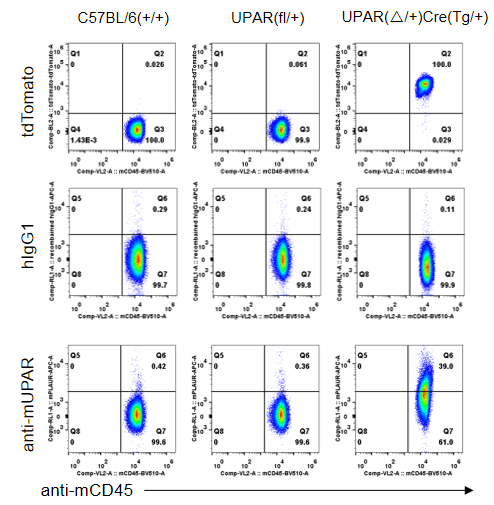


C57BL/6-Gt(ROSA)26Sortm1(CAG-LSL-mUPAR-IRES2-tdTomato)Bcgen/Bcgen • 111205
| Product name | B-CAG-Upar-tdTomato cKI mice |
|---|---|
| Catalog number | 111205 |
| Strain name | C57BL/6-Gt(ROSA)26Sortm1(CAG-LSL-mUPAR-IRES2-tdTomato)Bcgen/Bcgen |
| Strain background | C57BL/6 |
| Official symbol | Tgfb1(transforming growth factor, beta 1),Tgfb |
| Chromosome | 6 |
| Application | B-CAG-Upar-tdTomato cKI mice model is an efficient tool to study the mouse UPAR function in different tissues after cross with the tissue specification Cre mice. |
ROSAS26 gene produces a long non-coding RNA (lncRNA) that is under the control of a constitutive promoter. This locus is a widely used site for the integration of transgenes and reporter constructs.
Gene targeting strategy. The CAG-LSL-mUPAR-IRES2-tdTomato-WPRE-pA cassette that containing the full-length coding sequence of mouse Upar gene as well as tdTomato coding sequence were inserted into mouse Rosa26 gene locus site. The targeted mice crossed with Cre-expressing mice to implement tissue-specific expression.

Mouse UPAR expression analysis in B-CAG-Upar-tdTomato cKI mice by flow cytometry. The B-CAG-Upar-tdTomato cKI mice were cross breeding with CMV-Cre mice, which is useful for deletion of loxP-flanked genes in all tissues. The splenocytes were collected from the offspring mice in UPAR (△/+) Cre (Tg/+) genotype, and analyzed by flow cytometry with anti-mouse UPAR antibody. As shown, the mUPAR was detectable in offspring mice. In addition, the tdTomato will co-expression as a reporter.